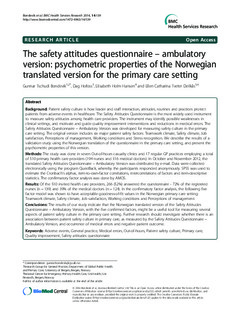| dc.description.abstract | Background
Patient safety culture is how leader and staff interaction, attitudes, routines and practices protect patients from adverse events in healthcare. The Safety Attitudes Questionnaire is the most widely used instrument to measure safety attitudes among health care providers. The instrument may identify possible weaknesses in clinical settings, and motivate and guide quality improvement interventions and reductions in medical errors. The Safety Attitudes Questionnaire – Ambulatory Version was developed for measuring safety culture in the primary care setting. The original version includes six major patient safety factors: Teamwork climate, Safety climate, Job satisfaction, Perceptions of management, Working conditions and Stress recognition. We describe the results of a validation study using the Norwegian translation of the questionnaire in the primary care setting, and present the psychometric properties of this version.
Methods
The study was done in seven Out-of-hours casualty clinics and 17 regular GP practices employing a total of 510 primary health care providers (194 nurses and 316 medical doctors). In October and November 2012, the translated Safety Attitudes Questionnaire – Ambulatory Version was distributed by e-mail. Data were collected electronically using the program QuestBack, whereby the participants responded anonymously. SPSS was used to estimate the Cronbach’s alphas, item-to-own-factor correlations, intercorrelations of factors and item-descriptive statistics. The confirmatory factor analysis was done by AMOS.
Results
Of the 510 invited health care providers, 266 (52%) answered the questionnaire - 72% of the registered nurses (n = 139) and 39% of the medical doctors (n = 124). In the confirmatory factor analysis, the following five factor model was shown to have acceptable goodness-of-fit values in the Norwegian primary care setting: Teamwork climate, Safety climate, Job satisfaction, Working conditions and Perceptions of management.
Conclusions
The results of our study indicate that the Norwegian translated version of the Safety Attitudes Questionnaire – Ambulatory Version, with the five confirmed factors, might be a useful tool for measuring several aspects of patient safety culture in the primary care setting. Further research should investigate whether there is an association between patient safety culture in primary care, as measured by the Safety Attitudes Questionnaire – Ambulatory Version, and occurrence of medical errors and negative patient outcome. | nb_NO |

